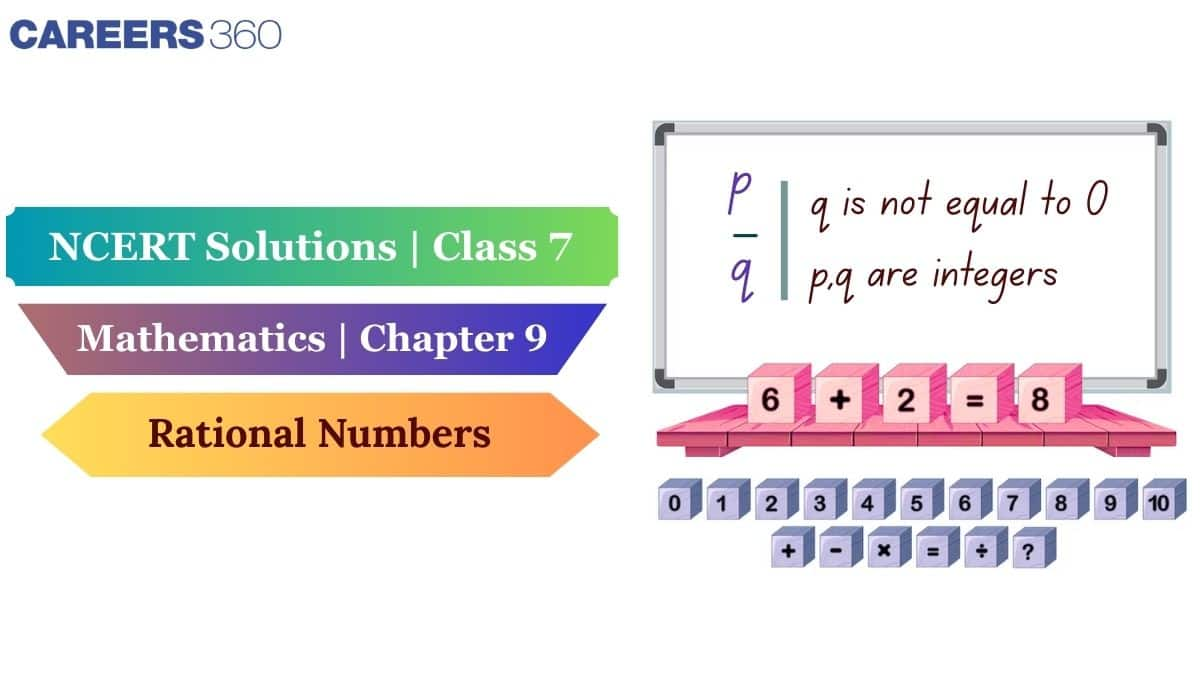ALLEN Coaching
ApplyRegister for ALLEN Scholarship Test & get up to 90% Scholarship
Rational numbers are numbers that can be expressed in the form

As these NCERT solutions for Class 7 Maths are prepared by subject matter experts from Careers360, it is one of the reliable and accurate study resources that could help the students in exam preparation. There are a total of 15 exercise questions in this chapter for which the step-by-step solutions are provided in this article.
A rational number can be expressed in the form of
Numerator and Denominator: In the
We obtain another equivalent rational number by multiplying the numerator and denominator with the same nonzero integer.
+ sign and positive integer: a position to the right of 0.
- sign and negative integer: a position to the left of 0.

Rational Numbers in Standard Form:
Its denominator is a positive integer.
The numerator and denominator have no common factor other than 1.
Examples:
Comparison of Rational Numbers:
Operations on Rational Number:
Addition of rational numbers :
Subtraction of rational numbers:
Multiplication of rational numbers:
Division of rational numbers:
Reciprocal of a rational number:
Reciprocal of
The product of rational numbers with its reciprocal is always 1.
NCERT Solutions for Class 7 Maths Chapter 8 Rational Numbers Exercise 8.1 Page Number: 133-135 Number of Questions: 10 |
Question: 1 (i) List five rational numbers between:
–1 and 0
Answer: To find five rational numbers between
So, we have five rational numbers between
Hence, the five rational numbers between -1 and 0 are:
Question: 1 (ii) List five rational numbers between:
–2 and –1
Answer: To find five rational numbers between
So, we have five rational numbers between
Hence, the required rational numbers are
Question: 1 (iii) List five rational numbers between:
Answer: To find five rational numbers between
Since there is only one integer i.e., -11 between -12 and -10, we have to find equivalent rational numbers.
Now, we have five rational numbers possible:
Hence, the required rational numbers are
Question: 1 (iv) List five rational numbers between:
Answer: To find five rational numbers between
Making denominator as LCM(2,3)=6
that is
Now, we have five rational numbers possible:
Hence, the required rational numbers are
Question: 2 (i) Write four more rational numbers in each of the following patterns:
Answer: We have the pattern:
Now, following the same pattern, we have
Hence, the required rational numbers are:
Question: 2 (ii) Write four more rational numbers in each of the following patterns:
Answer: We have the pattern:
Now, following the same pattern, we have
Hence, the required rational numbers are:
Question: 2 (iii) Write four more rational numbers in each of the following patterns:
Answer: We have the pattern:
Now, following the same pattern, we have
Hence, the required rational numbers are:
Question: 2 (iv) Write four more rational numbers in each of the following patterns:
Answer: We have the pattern:
Now, following the same pattern, we have
Hence, the required rational numbers are:
Question: 3 (i) Give four rational numbers equivalent to:
Answer:
Hence, the required equivalent rational numbers are
Question: 3 (ii) Give four rational numbers equivalent to:
Answer:
Hence, the required equivalent rational numbers are
Question: 3 (iii) Give four rational numbers equivalent to:
Answer:
Hence, the required equivalent rational numbers are
Question: 4 (i) Draw the number line and represent the following rational numbers on it:
Answer: Representation of

Question: 4 (ii) Draw the number line and represent the following rational numbers on it:
Answer: Representation of

Question: 4 (iii) Draw the number line and represent the following rational numbers on it:
Answer: Representation of

Question: 4 (iv) Draw the number line and represent the following rational numbers on it:
Answer: Representation of

![]()
Answer: Given TR = RS = SU and AP = PQ = QB then, we have
There are two rational numbers between A and B i.e., P and Q which are at equal distances hence,
The rational numbers represented by P and Q are:
Also, there are two rational numbers between U and T i.e., S and R which are at equal distances hence,
The rational numbers represented by S and R are:
Question: 6 Which of the following pairs represent the same rational number?
(i)
(iii)
(v)
(vii)
Answer: To compare we multiply both numbers with denominators:
(i) We have
Here, they are equal but are in opposite signs hence,
(ii) We have
So, they represent the same rational number.
(iii) We have
Here, Both represent the same number as these minus signs on both numerator and denominator of
(iv) We have
So, they represent the same rational number.
(v) We have
So, they represent the same rational number.
(vi) We have
So, They do not represent the same rational number.
(vii) We have
Here, the denominators of both are the same but
So,
Question: 7 Rewrite the following rational numbers in the simplest form:
(i)
Answer: (i)
(ii)
(iii)
Question: 8 Fill in the boxes with the correct symbol out of >, <, and =.
(i)
(iv)
(vii)
Answer: (i)
Hence,
(ii)
Hence,
(iii)
Hence,
(iv)
Hence,
(v)
Hence,
(vi)
Hence,
(vii)
Zero is always greater than every negative number.
Therefore,
Question: 9 Which is greater in each of the following:
(i)
(iii)
(v)
Answer: (i)
Since,
So,
(ii)
Since,
So,
(iii)
Since,
So,
(iv)
As each positive number is greater than its negative.
(v)
So,
Question: 10 (i) Write the following rational numbers in ascending order:
Answer: (i) Here the denominator value is the same.
Therefore,
Hence, the required ascending order is
Question: 10 (ii) Write the following rational numbers in ascending order:
Answer: Given
LCM of
Therefore, we have
Since
Hence, the required ascending order is
Question: 10 (iii) Write the following rational numbers in ascending order:
Answer: Given
LCM of
Therefore, we have
Since
Hence, the required ascending order is
NCERT Solutions for Class 7 Maths Chapter 8 Rational Numbers Exercise 8.2 Page Number: 141 Number of Questions: 4 |
Question: 1 (i) Find the sum:
Answer: Given sum:
Here the denominator is the same which is 4.
Question: 1 (ii) Find the sum:
Answer: Given sum:
Here the LCM of 3 and 5 is 15.
Hence, we can write the sum as:
Question: 1(iii) Find the sum:
Answer: Given sum:
Taking the LCM of 10 and 15, we have 30
Question: 1 (iv) Find the sum:
Answer: Given sum:
Taking LCM of 11 and 9 we have,
Question: 1 (v) Find the sum :
Answer: Given sum:
Taking LCM of 19 and 57, we have 57
We can write the sum as:
Question: 1 (vi) Find the sum:
Answer: Given sum:
Adding any number to zero we get, the number itself
Hence,
Question: 1 (vii) Find the sum:
Answer: Given the sum:
Taking the LCM of 3 and 5 we have: 15
Question: 2(i) Find
Answer: Given sum:
We have LCM of 24 and 36 will be, 72
Hence,
Question: 2 (ii) Find
Answer: Given
LCM of 63 and 21 is 63,
Then we have;
Question: 2 (iii) Find
Answer: Given
We have, LCM of 13 and 15 is 195.
Then,
Question: 2 (iv) Find
Answer: Given
LCM of 8 and 11 is 88, then
Question: 2 (v) Find
Answer: Given:
LCM of 9 and 1 will be, 9
Hence,
Question: 3 (i) Find the product:
Answer: Given product:
Question: 3 (ii) Find the product:
Answer: Given
So the value
Question: 3 (iii) Find the product:
Answer: Given product:
The value of given product is
Question: 3 (iv) Find the product:
Answer: Given product
Question: 3 (v) Find the product:
Answer: Given product:
Question: 3 (vi) Find the product:
Answer: Given product:
Question: 4 (i) Find the value of:
Answer: Given:
Dividing
Question: 4 (ii) Find the value of:
Answer: Given
Dividing
Question: 4 (iii) Find the value of:
Answer: Given:
So, dividing
Question: 4 (iv) Find the value of:
Answer: Given:
Simplifying it:
Question: 4 (v) Find the value of:
Answer: Given:
Simplifying it: we get
Question: 4 (vi) Find the value of:
Answer: Given:
Simplifying it: we get
Question: 4 (vii) Find the value of:
Answer: Given:
Simplifying it: we get
Rational number: A rational number is a number that can be represented as
Numerator and Denominator: In the
Comparison of Rational Numbers:
Operations on Rational Number:
Addition of rational numbers :
Subtraction of rational numbers:
Multiplication of rational numbers:
Division of rational numbers:
Reciprocal of a Rational Number: Reciprocal of
(Rational number)(Reciprocal) = 1
The NCERT Subject wise solutions for Class 7 gives step by step solutions to all the chapters in each subject. Click the link below to access the subject wise solutions for Class .
Also Check NCERT Books and NCERT Syllabus here:

Register for ALLEN Scholarship Test & get up to 90% Scholarship

Get up to 90% Scholarship on Offline NEET/JEE coaching from top Institutes

This ebook serves as a valuable study guide for NEET 2025 exam.

This e-book offers NEET PYQ and serves as an indispensable NEET study material.
As per latest 2024 syllabus. Physics formulas, equations, & laws of class 11 & 12th chapters
As per latest 2024 syllabus. Chemistry formulas, equations, & laws of class 11 & 12th chapters